Grooming during the bad season
Rain, mud, wind, black ice, frost, cold are the parameters to be taken into consideration to take good care of your horse during Winter, inside or outside. Here is a little list of details that will increase his comfort and make your stable life easier.
BEFORE TRAINING
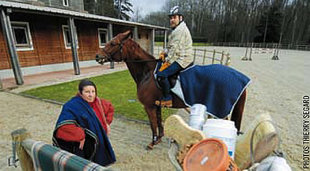
• « When it's cold, a clipped horse must not stand still naked. Blankets must not be taken away suddenly in order to avoid a thermal shock, the horse must be undressed progressively. » Starting from the rain sheet; leave the sheet the time needed to groom, to be worn again as soon as the horse has been brushed. In this case, nothing must be left on his back while grooming, neither blanket nor exercise rug, to avoid a cold shock when going out.
• If the ground is wet, muddy, grease the hoofs and take care of the little scratches before going out. « During winter it is better to use a black hoof polish; it better remains on the hoof thanks to the tar in it. In Summer, on the contrary, you should prefer a clear hoof polish, more nourishing and less drying than the black one. »
• If the frog is in a bad state, thoroughly apply some Norwegian tar in order to avoid contact with dampness « Don't wholly cover the outer hoof wall but stop half-way up and go on with a classic hoof treatment. »
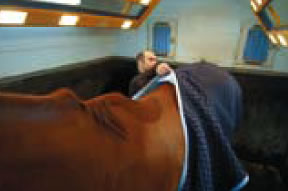
• Fissures and scabs (mud mange) don't love dampness either; they should be covered with Vaseline to prevent soil and sand from reaching the sores. « Some people put talcum powder on the fissures before training. I don't agree with this if they go out under the rain and in the mud; with water, the talc mixes up and becomes a pulp which doesn't protect anything. »
• « In order to protect the limbs on a muddy ground, prefer plastic boots (easier to clean than the leather ones) to polo wraps. » They are easily soaked (which is dangerous for tendons), and the washing necessary after each ride endangers the Velcro fastenings which might part away (put 2 or 3 rounds of adhesive tape to fix them). The best thing is to prepare the horse under a solarium.
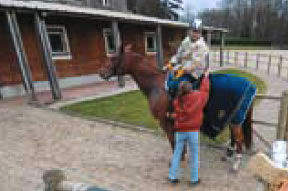
• In case of intense cold, you can add a wool cover under the exercise rug, to be taken away after a progressive warming up (please carry out a long walking and trotting session to warm up muscles and avoid muscles strains!). During the training please have the horse wear only the exercise rug. « The horse should not sweat; if he does, a cold shock is guaranteed. If the warm up is done wearing a blanket, you must not wait for the horse feeling too hot to take it away; if he is already wet, it is too late to do it. » The same principles must be respected for lungeing.
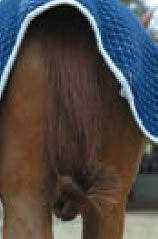
• An ear net protects ears against wind and cold. In order not to come back with a muddy and soaked tail, it must be raised : you can tie a knot (tight) or a big braid folded twice or three times under the dock, fixed with an adhesive tape; or also wear a tail protection, as the ones used in the western riding.
• « If it's freezing and the horse is shoed, don't get into the saddle on the asphalt, even with the help of a step, to avoid sliding. » If the accesses to the stable are smooth and slippery, mount in the indoor school or on a steady ground, without any risk of skidding when starting.
TRICKS : THE EXERCISE RUG
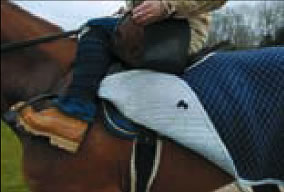
For a good use and a good hold of the exercise rug, slip it under the saddle flap…
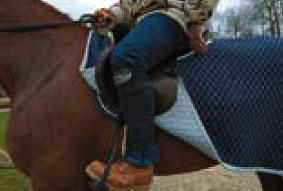
… Then put the flap at its place, and normally stretch your leg.
AFTER TRAINING
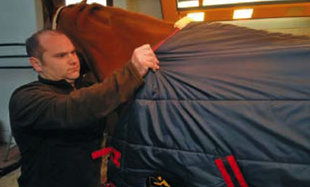
• « Immediately cover the horse as soon as the session is over ; never walk without a blanket, mounting or driving the horse by hand. Also don't ever bring him to his box and put the blankets on his back until he is completely dry and has recovered. » Once unsaddled, if he's sweating and still « smokes », use a sweat scrapper, rub (if he is not clipped), put fleece cooler + a polar fleece and go on walking until he is dry before dressing him with his stable blanket(s).
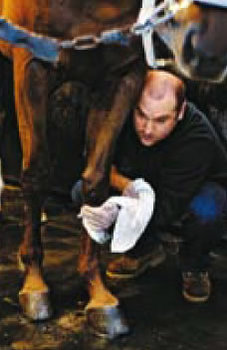
• Be careful not to leave the horse in a draught while grooming him, even though he is dry, even less if wet, or even covered. Draughts are in this case more dangerous than cold itself.
• If you cannot give the horse a shower, clean dirty areas with warm water (limbs, breast, belly, inner thighs) with a big sponge and immediately dry. Without forgetting to leave back and loins covered.
• « Don't leave him wearing the sheet or blanket in which he dried ; dampness will go down and cool the body, he will surely suffer from a cold shock, even though you added a warm and dry blanket on top. It is necessary that he is well dried under all layers. »
• Rubbing the whole body with alcohol is useful to dry the horse more quickly. « After a shower is ok, but I wouldn't do it after training: alcohol fills skin pores, blocks perspiration, toxins remain inside. This is not good for the organism. »
• Avoid placing cotton rolls and stable bandages on wet limbs. « This blocks and keeps dampness on the tissues through hair, consequently causing fissures in the pastern fold » ; don't try to go faster using a hairdryer; this can burn skin and it definitely dries it. Putting damp or wet cotton rolls or wraps on dry limbs is also to be forbidden.